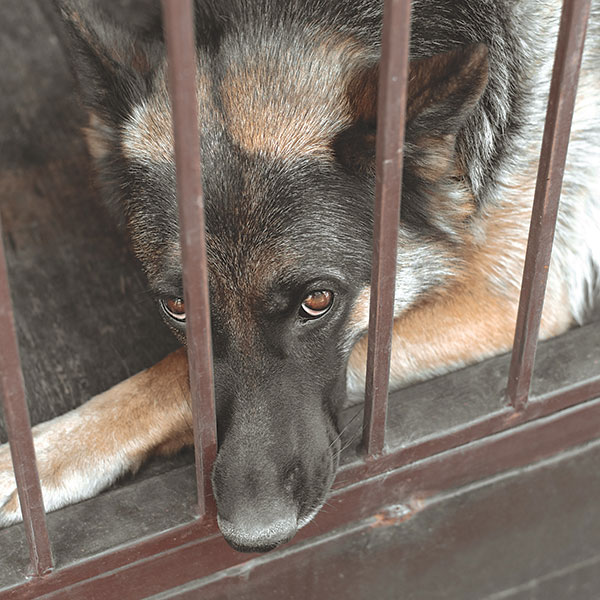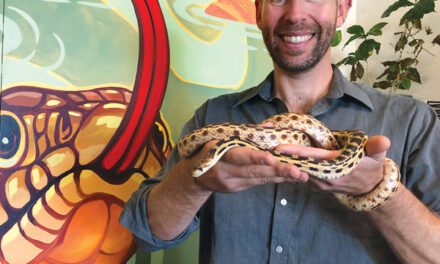Smart, Loyal, Energetic
Training is key to keeping German shepherds out of shelters
By Cathryn Rakich
May 2022
Walk through the county’s animal shelter on Bradshaw Road. The high-ceiling entryway opens to a spacious roundabout surrounded with glass-walled condos, each holding one or two large dogs, many pit bulls and German shepherds, and their mixed counterparts.
Stroll through the back door to an open-air corridor. Large windows allow visitors to view groups of small dogs housed together. Chihuahua and chihuahua mixes run back and forth, yelping with excitement. Further down are hallways lined with kennels housing medium and large dogs. Again, pit bulls and German shepherds dominate.

When did German shepherds start keeping pace with pit bulls and chihuahuas, which have been the prevailing breeds in shelters for years?
“There is definitely an increase in German shepherds up and down the state,” says Bradshaw’s director, Annette Bedsworth.
Last year, the Bradshaw Animal Shelter took in 452 German shepherds and German shepherd mixes. The Sacramento SPCA took in 420. German shepherds ranked No. 2, behind pit bulls, at the city’s Front Street Animal Shelter, which took in 466.
“Unaltered German shepherds can give birth to up to 15 puppies—with eight puppies the average litter size,” says Dawn Foster, SSPCA marketing and communications director. “This means the population can grow very quickly if they are not spayed or neutered, overwhelming families and shelters.”
German shepherds are often used as guard dogs to protect property. “In many cases they are primarily outdoor dogs in yards that are not properly secured or they are living on a property that is not inhabited and their owners are unaware they are loose,” says Allison Harris, Sacramento County public information officer.
For Cindy Williams, founder of El Dorado County German Shepherd Rescue, the reason for the increase is threefold: popular movies, COVID and lack of training.
For example, the 2015 movie “Max” stars a military dog that helps American Marines in Afghanistan. The 2021 movie “Dog” takes viewers on a road trip with an Army ranger and his mischievous canine. In both movies, the dogs are Belgium Malinois, which look like German shepherds.
“People get them mixed up all the time,” Williams says. “They want anything with perky ears standing up that looks wolfish.” Plus, dogs in movies appear well trained. “They don’t realize that training for the Malinois can be 10 hours a day, solid every day.”
Bedsworth agrees. “Belgium Malinois are beautiful dogs—and they’re smart,” she says. “But with the wrong type of home environment, they are going to end up in shelters because they are extremely high-energy dogs. You can’t just put them in the backyard and expect them to thrive. It’s not going to work.”
German shepherds are known for their intelligence, loyalty and strength. They are a herding or working breed. Without physical and mental exercise, they are prone to anxiety and nervous aggression.
“German shepherd puppies are incredibly cute and adopters are often attracted to the breed because of their appearance and intelligence,” Foster says. “However, not every family is prepared to provide the mental and physical stimulation needed to keep this breed happy and healthy.”
If they don’t receive training at an early age, as well as regular exercise, they can become destructive and difficult to manage, Foster says. “These behaviors often result in them being surrendered to a shelter.”
The pandemic didn’t help. Due to the COVID lockdown, people were not getting professional training for their new four-legged family members or taking them out for socialization. “It was a kick in the pants for everybody,” Williams says. “Now you have these dogs who are going on 15 months to 2 years old who didn’t get socialized. ‘My dog is reacting to other dogs.’ Well of course he is. He never got out. He doesn’t know what to do.”
With more people working from home with extra time for a pet, shelter adoptions were up. Some saw a chance to capitalize on the craze. “I think people were breeding German shepherds to make money,” Bedsworth says.
In addition, large dogs have longer lengths of stay in the shelters. “Mom and Dad want a little lap dog. They fly out the door,” Bedsworth adds. “German shepherds and pit bulls take longer to adopt out.”
German shepherds, who have a lifespan of 9 to 13 years, are also prone to hereditary issues, such as hip dysplasia, that can be expensive to treat.
Williams wants people to know there are resources to help families keep their animal companions, whether the problem is behavioral, medical or financial. “If you are having any issues or challenges with your dog, reach out to a reputable trainer. Call a rescue group. We can tell you where to go, what to do and give you tips.”
Cathryn Rakich can be reached at crakich@surewest.net. Follow us on Facebook, Twitter and Instagram: @insidesacramento.















